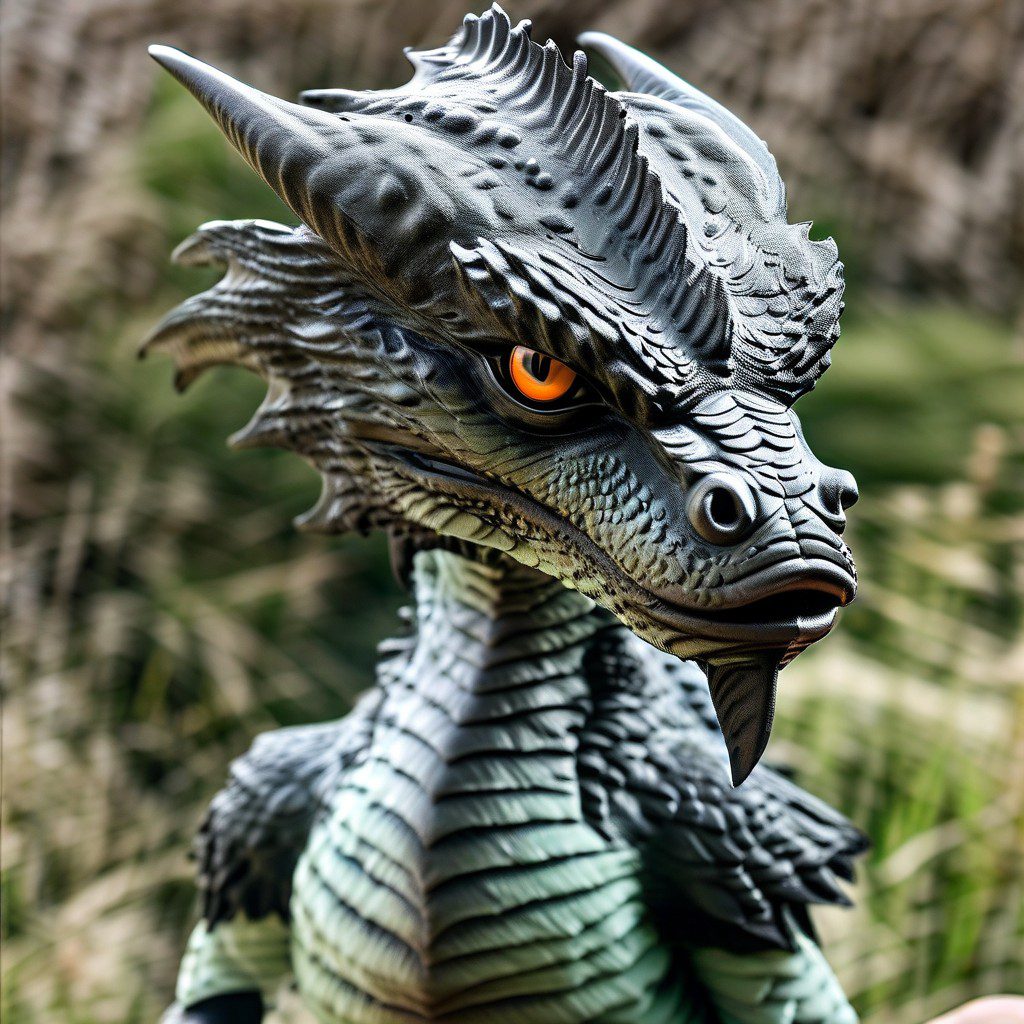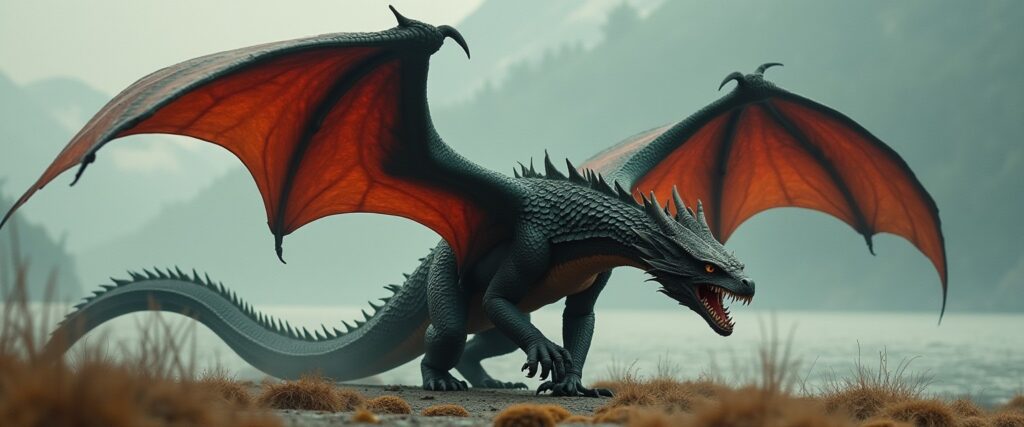Wyverns: The Fierce and Deadly Dragons of Myth and Fantasy

Wyverns are a type of dragon-like creature commonly depicted in European mythology and modern fantasy. While similar to traditional dragons, wyverns are typically distinguished by having two legs rather than four. They are known for their fierce nature, their predatory instincts, and their association with venom or poison. In heraldry, video games, literature, and film, wyverns are often portrayed as dangerous beasts, less intelligent but more agile than their larger, more powerful dragon cousins.
Wyverns are a type of dragon-like creature commonly depicted in European mythology and modern fantasy. While similar to traditional dragons, wyverns are typically distinguished by having two legs rather than four. They are known for their fierce nature, their predatory instincts, and their association with venom or poison. In heraldry, video games, literature, and film, wyverns are often portrayed as dangerous beasts, less intelligent but more agile than their larger, more powerful dragon cousins.
Origins of the Wyvern in Mythology
The concept of the wyvern likely has roots in European medieval and Renaissance heraldry, where the creature was often used as a symbol of strength and protection. The word “wyvern” itself is derived from the Middle English word wyvere, meaning “viper” or “serpent.” Wyverns were often associated with serpentine creatures and were believed to have reptilian or dragon-like qualities.
In medieval bestiaries, wyverns were depicted as fearsome creatures with dragon-like bodies, two legs, and large wings. Unlike traditional dragons, which were often portrayed as wise or even god-like creatures, wyverns were usually considered bestial predators. Their image appeared frequently in heraldic crests, shields, and banners as symbols of protection, aggression, and dominance.
Wyverns in Modern Fantasy
In modern fantasy literature, role-playing games, and media, wyverns are often depicted as a distinct subspecies of dragons. Though they share many similarities with traditional dragons—such as their wings, scales, and ability to fly—wyverns are characterized by their more animalistic and feral nature.
Distinguishing Wyverns from Dragons
The main difference between wyverns and traditional dragons lies in their anatomy:
- Wyverns: Usually depicted with two legs and two wings. They often lack the front legs that four-legged dragons have, meaning they either walk on their hind legs or use their wings to support themselves. This gives them a more streamlined, bird-like appearance.
- Dragons: Generally have four legs and two wings, making them more versatile in combat and movement. Dragons are typically portrayed as highly intelligent creatures capable of speech, magic, and cunning, whereas wyverns are often depicted as more beastly.
Abilities and Characteristics

Wyverns in fantasy often have specific traits that set them apart from dragons:
- Poisonous or Venomous: In many depictions, wyverns are known for their venomous bite or stinger, which can incapacitate or kill their prey. This venomous trait makes them especially deadly, as they can attack with both physical and chemical weapons.
- Feral Nature: Unlike dragons, which are often intelligent and capable of forming alliances or hoarding treasure, wyverns are typically portrayed as more primitive and animalistic. They are driven by instinct rather than intellect and are often shown as aggressive, territorial creatures.
- Flight and Speed: Wyverns, being smaller and more agile than traditional dragons, are often depicted as fast and nimble in the air. Their wings make them excellent flyers, and they are usually portrayed as dangerous aerial predators capable of diving down on unsuspecting prey.
Wyverns in Popular Media
Wyverns have become a staple in modern fantasy, appearing in many video games, movies, and literature as fearsome enemies or wild beasts to be tamed.
1. Video Games
- The Witcher: In the Witcher series, wyverns are dangerous, dragon-like creatures that are more animalistic than true dragons. They are often encountered in the wild and pose significant threats to adventurers.
- Dark Souls: Wyverns appear as powerful, aggressive creatures in the Dark Souls series. While not as intelligent as the game’s ancient dragons, they are formidable foes due to their speed and aerial attacks.
- Monster Hunter: Wyverns, especially “Flying Wyverns,” are a significant category of monsters in the Monster Hunter series. These creatures are agile and dangerous, and players often hunt them in elaborate battles.
2. Literature
- A Song of Ice and Fire by George R. R. Martin: While dragons are more prominent in Martin’s universe, wyverns are mentioned as lesser, more animalistic creatures found in the lands of Sothoryos. They are considered dangerous but not as intelligent or magical as dragons.
- The Belgariad by David Eddings: Wyverns appear as dangerous, winged creatures, often posing threats to travelers and adventurers.
3. Films and TV
- Game of Thrones: Though not directly depicted, wyverns are alluded to in the broader A Song of Ice and Fire universe. In Game of Thrones, dragons are dominant, but references to wyvern-like creatures exist in background lore.
- The Hobbit: The Desolation of Smaug: While the dragon Smaug is the primary antagonist, his more streamlined design in the film, with two legs and wings, resembles the wyvern anatomy. Though Smaug is still considered a dragon in the story, the visual similarities to wyverns are notable.
Strengths and Weaknesses of Wyverns
Strengths:
- Agility and Speed: Wyverns are often faster and more agile than larger, four-legged dragons. Their ability to quickly strike from the air makes them deadly predators.
- Venomous or Poisonous: Many depictions of wyverns feature a venomous bite or a poisonous stinger, adding a lethal element to their already formidable physical attacks.
- Ferocity: Wyverns are often depicted as more aggressive than dragons, with a raw, primal nature that makes them relentless in combat.
Weaknesses:
- Lack of Intelligence: Unlike their dragon counterparts, wyverns are typically portrayed as less intelligent. They may rely on brute force or instinct, which can make them easier to outsmart.
- Limited Magical Abilities: While dragons are often associated with magic, speech, and the accumulation of wisdom, wyverns usually lack these traits. They are not portrayed as spellcasters or treasure-hoarders but as simple, wild beasts.
- Fewer Limbs: Wyverns’ two-legged anatomy can be a limitation compared to the four-legged, more versatile dragons. This makes them slightly less adept at grappling or ground-based combat.
The Legacy of Wyverns: Fierce and Primal
Wyverns have earned a place in modern fantasy as the smaller, deadlier cousins of dragons. Their streamlined design, swift movements, and venomous traits make them a popular choice for storytellers and game designers seeking a fearsome aerial predator. While they may lack the grandeur and intelligence of traditional dragons, wyverns embody the wild, untamed side of draconic mythology.
In both ancient heraldry and modern fantasy, wyverns remain symbols of raw power, aggression, and danger, ensuring their place as one of the most feared creatures in any fantasy setting.
